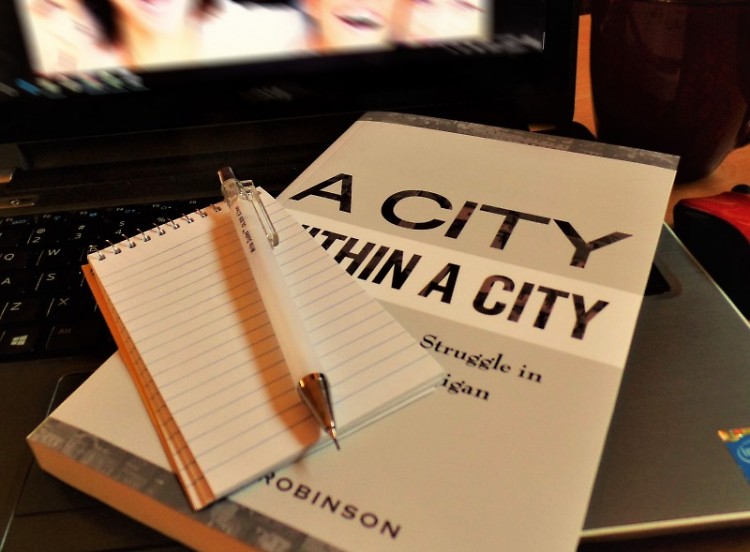Part 1 of 4
Nine white people looked out at us from the computer screen. Seven were men. All were small business owners. For many, the photo was the first thing they saw, and it told a story often typical of West Michigan.
The photo accompanied an article on the highlights of a roundtable talk among the local entrepreneurs pictured in the photo. MiBiz, an online publication, hosted the discussion, focusing on the economic outlook for 2017. The headline read "Diversity, uncertainty top of mind for small biz executives."
Since the topic of diversity was important enough to headline the article, I decided to continue the conversation and talk to the people involved. I talked to the editor at MiBiz, a roundtable participant, and readers who responded to the article. Then I formed some ideas and opinions based on those conversations.
In this first part of the series, I reflect that traditional business coverage tries to achieve diversity but often omits covering systemic bias. This is part of how that bias perpetuates itself. Grand Rapids is 64.6% white within city limits -- that percentage is 83.1 percent in the metro area.
West Michigan has historically had a difficult time attracting diverse entrepreneurs and professionals, and there's a much higher rate of poverty among people of color in the area than for whites. Given this context, traditional business news may not offer information that truly works for everyone.
‘If you’re a white guy’
In the MiBiz roundtable, when asked if West Michigan is good for small businesses, some of the participants brought up race and equity issues.
Mike Morin from Start Garden said, "If you’re a white guy, yeah. If you’re an African-American, no."
Rob McCarty from The Image Shoppe said, "If there’s one thing that’s not a radar item right now… diversity in our business needs to be out there."
"From gender to race to income inequality gaps...I don’t think it goes down good for us if we ignore it."
Chris Reinbold of Six/Ten Ventures and The Funky Buddha Yoga Hothouse said, "I think that reputation is there already. Forbes named us the worst city in America for African-American professionals."
The panel then touched on possible actions: diversity in lateral hiring to provide mentors, finding a metric to measure progress and creating a dynamic culture to attract diversity.
Reader reactions
As the article was shared, some readers commented that voicing concerns about diversity wasn’t enough to create the real action needed. Others like, Adriane Johnson, felt if more women, people of color, and others from marginalized groups weren’t included in discussions like this roundtable, there would be no resolution.
‘How journalism is supposed to work’
Joe Boomgaard, editor of MiBiz, acknowledged the problem. “In our editorial meetings, we prioritize ways to reach a diverse group of participants that represent our area geographically, a mix of men, women and voices from various races, sexual orientations, etc.
Boomgaard said that with this roundtable more participants were invited, but could not attend including “a board member of a local Hispanic business organization [who] had to bow out at the last minute,” due to the season’s first heavy snowstorm.
“I’m cognizant of the fact that most people in power in the region are white males. They’re typically the senior executives we seek out for comment. ...[But] we’re not just trying to reflect diversity. Our reporting should help readers make money, save money and find money to grow their businesses, and that’s regardless of race, sex, age, or orientation.”
“We reflect the West Michigan business community as it is — not what we would like it to be. That’s how journalism is supposed to work.”
Opinion: journalism can approach power structures in various ways
The staff at MiBiz clearly works hard to create original, in-depth stories with a nod to diversity, and my next points are not about MiBiz in particular. In fact, Boomgaard’s last point is a common one in journalism. It speaks to how diverse representation — in panels and among journalists —matters. Seeing the business community “as it is” involves many moving parts in a city the size of Grand Rapids. Selection of which factors to present depends on one’s view of the systems in play -- one’s view depends on one’s experience with those systems and their bias.
Traditional business coverage often presents events as though they are not influenced by systemic bias — as though it doesn’t exist. Calling out examples of institutional bias is not name-calling — it's not personal, but about systems. When institutions like the press present racism and bias as "the way it is," without question, that bias is perpetuated.
Put another way, the press often paints the picture that racism hands it.
In a city like ours, with a history of institutional racism, nothing changes until institutions like the press start using their leverage to question that picture. The diversity that news organizations seek depends upon that critical thinking.
It is also true that for several reasons, the typical business news approach may not offer economic information in ways that would help marginalized readers make, save, and find money to grow businesses.
Suggestions:
- Several narratives: Because of segregation and systemic bias, any business story may have several narratives around it. The Wealthy Street corridor is one example. For many white people, this area has turned into a “good neighborhood” where they can entertain guests. For many Black people, after years of no investment, the influx of capital meant that Black-owned businesses were gone, developers were circling, and longtime residents were priced out of their homes. (A related MiBiz story by Nick Manes is quite successful at seeking out alternate narratives.)
- Presenting barriers: Systemic barriers are often numerous and not readily apparent to white people or others who experience privilege. An example: Black-owned businesses often lack capital. African-American readers may need more coverage about those barriers and possible solutions, such as cooperative businesses that pool resources (which was the topic of The Shift Summit in November).
- Looking at power outside of white definitions: Readers who lack access may need more coverage about power mapping and how to move power into their neighborhoods and businesses. Coverage of local entrepreneurs/activists of color who deal with these concepts, like Leslie Mac, may offer readers more useful ideas.
- Two cities: Grand Rapids is often described as a city within a city, and business news has not typically provided helpful information for residents of that “inner city.” As a white woman who has covered Grand Rapids Area Black Businesses, The Shift Summit, and the African-American Museum, I’ve glimpsed business networks and layers of the economy that I don’t see covered very often. Yet these networks have a history and are actively building connections. I have been curious if others see these networks: they seem as much a part of “what is” as more typical stories that involve white businessmen.
As Boomgaard concluded, “What we can do is continue to seek out new voices, broaden our contacts and meet with people who may not look like us, but who bring a unique perspective to the story. We fail — a lot — but with every new issue there’s an opportunity to try again.”
I appreciate his efforts and his honesty. As the equity conversation changes in our city and elsewhere, the opportunities to try again could involve greater anti-racism work by news sources, business and otherwise. Representation is only a first step. Questioning the picture painted by historical, institutional bias may be the only way to overcome the barriers to truly serving all readers.
The rest of the series:
Part 2: explores measurable longterm strategies for equity.
Part 3: uncovers a common theme in the journey to equity - mentoring.
Part 4: entrepreneur Adriane Johnson speaks out
The Rapidian, a program of the 501(c)3 nonprofit Community Media Center, relies on the community’s support to help cover the cost of training reporters and publishing content.
We need your help.
If each of our readers and content creators who values this community platform help support its creation and maintenance, The Rapidian can continue to educate and facilitate a conversation around issues for years to come.
Please support The Rapidian and make a contribution today.



